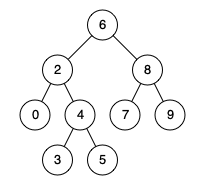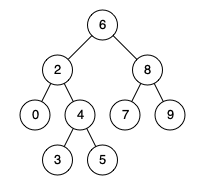235. Lowest Common Ancestor of a Binary Search Tree
Given a binary search tree (BST), find the lowest common ancestor (LCA) of two given nodes in the BST.
According to the definition of LCA on Wikipedia: “The lowest common ancestor is defined between two nodes p and q as the lowest node in T that has both p and q as descendants (where we allow a node to be a descendant of itself).”
1
2
3
4
5
| Example 1:
Input: root = [6,2,8,0,4,7,9,null,null,3,5], p = 2, q = 8
Output: 6
Explanation: The LCA of nodes 2 and 8 is 6.
|

1
2
3
4
5
| Example 2:
Input: root = [6,2,8,0,4,7,9,null,null,3,5], p = 2, q = 4
Output: 2
Explanation: The LCA of nodes 2 and 4 is 2, since a node can be a descendant of itself according to the LCA definition.
|

1
2
3
4
| Example 3:
Input: root = [2,1], p = 2, q = 1
Output: 2
|
Constraints:
- The number of nodes in the tree is in the range [2, 105].
- -109 <= Node.val <= 109
- All Node.val are unique.
- p != q
- p and q will exist in the BST.
Solution#
1
2
3
4
5
6
7
8
9
10
11
12
13
14
15
16
17
18
19
20
| /**
* Definition for a binary tree node.
* public class TreeNode {
* int val;
* TreeNode left;
* TreeNode right;
* TreeNode(int x) { val = x; }
* }
*/
class Solution {
public TreeNode lowestCommonAncestor(TreeNode root, TreeNode p, TreeNode q) {
if (root.val < p.val && root.val < q.val) {
return lowestCommonAncestor(root.right, p, q);
}
if (root.val > p.val && root.val > q.val) {
return lowestCommonAncestor(root.left, p, q);
}
return root;
}
}
|

